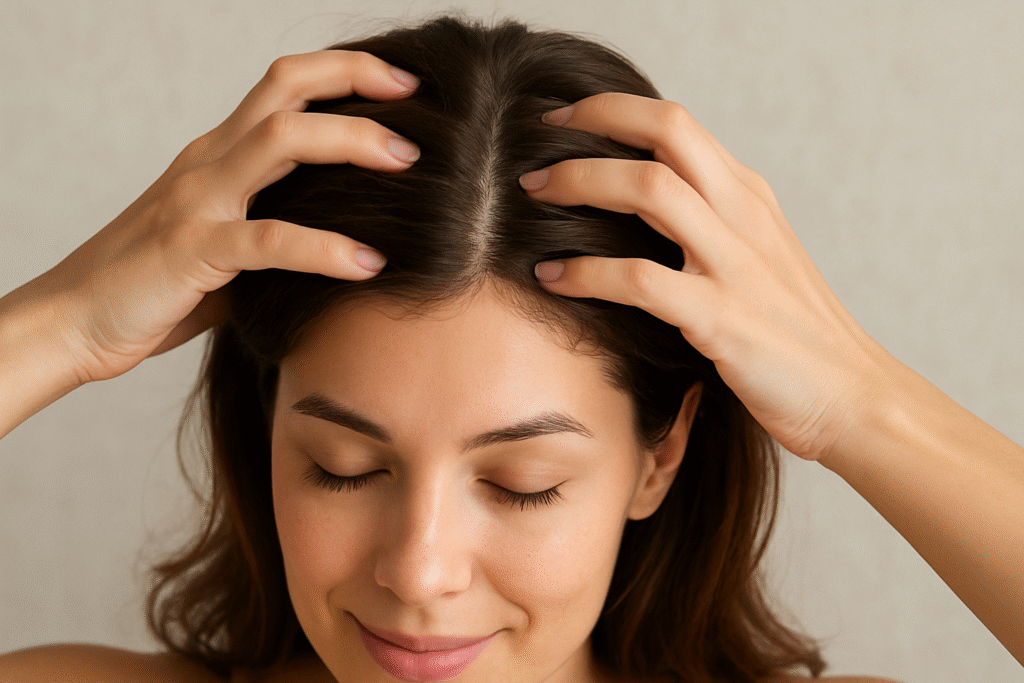Table of Contents
Introduction
Raise your hand if your ponytail feels skinnier than last year—mine certainly did. After two months of watching my strands deflate, I dove into dermatology papers, spoke to stylists, and tested every volumizing trick I could find. The result is a practical, research‑driven roadmap that helped my hair regain bounce within twelve weeks—and can do the same for you.
In this guide you’ll learn why hair loses volume, how to increase hair volume with daily habits and styling upgrades, and when dermatologist‑backed treatments make sense. You’ll also get a 12‑week plan, safety notes, and a plain‑English FAQ.
Medical disclaimer: This guide is educational and not a substitute for medical advice. If you’re pregnant, breastfeeding, have a medical condition, or take prescription medicines, consult a qualified clinician before starting treatments or supplements.
Why Hair Loses Volume
Volume depends on two things:
- Density — how many hairs grow per square centimetre.
- Diameter — the thickness of each strand.
When density or diameter drop, hair looks flat, gaps show at the part, and the crown deflates. The usual culprits:
- Hormonal shifts: Postpartum dips, peri‑menopausal changes, or PCOS can shorten the growth (anagen) phase and increase sensitivity to DHT, the by‑product linked with miniaturization.
- Nutrition gaps: Inadequate protein, low ferritin (iron stores), low vitamin D, or zinc deficiency quietly thin strands.
- Heat/chemical damage: Over‑styling roughens the cuticle and leads to breakage—less bulk in your ponytail.
- Stress & poor sleep: Chronic cortisol nudges follicles into the resting (telogen) phase; shedding often appears 2–3 months after stress peaks.
- Genetics & age: Some follicles are more DHT‑sensitive; the right topicals and in‑clinic options can help slow or reverse miniaturization.
How to Increase Hair Volume: 17 Strategies
Each strategy below includes: What to do, Why it works, Best for, and Watch‑outs. Use the “Try it today” tips to take immediate action.
1) Eat for Volume: Protein, Ferritin, Vitamin D & Zinc
What to do:
Aim for ~0.8 g protein per kg body weight/day at minimum (e.g., 60 kg → ~48 g/day). Build meals around eggs, fish, Greek yogurt, dal/lentils, soy, paneer/tofu, and nuts. Request a blood test for ferritin, vitamin D, zinc, and B12 to tailor supplementation.

Why it works:
Hair is mostly keratin—a protein. Adequate amino acids, sufficient iron stores (ferritin), vitamin D and zinc support robust growth cycles and thicker shafts.
Best for:
Diffuse thinning, fatigued hair, new vegetarians/vegans, heavy exercisers.
Watch‑outs:
Don’t supplement iron without testing; excess can be harmful.
Try it today: Scramble two eggs with spinach + a bowl of Greek yogurt for a fast 25–30 g protein breakfast.
2) Lower Daily Stress (Cortisol) with Simple Routines
What to do:
Pick one 10–20‑minute practice you’ll stick to: brisk walk, guided breathing, or journaling—daily.
Why it works:
Lower, steadier cortisol supports normal signaling within the follicle and reduces telogen shifts.
Best for:
Post‑illness, post‑breakup, career stress, new moms.
Try it today: 4‑7‑8 breathing (inhale 4, hold 7, exhale 8) for five cycles before bed.
3) Sleep 7–8 Hours + Silk Pillowcase
What to do:
Protect a regular sleep window and swap cotton for silk/satin to reduce friction.
Why it works:
Deep sleep pulses of growth hormone assist tissue repair; lower friction = fewer breaks = visibly fuller ends.
Try it today: Lights‑out, devices off, and a cool room (~18–20 °C) for faster sleep onset.
4) Daily 4‑Minute Scalp Massage
What to do:
Use fingertips (not nails) in slow circles from nape → crown → temples for 4 minutes daily. Oil optional.

Why it works:
Improves micro‑circulation and may increase average strand diameter over time.
Watch‑outs:
Skip vigorous rubbing if you have inflammatory scalp conditions; patch test any essential oils.
5) Gentle Cleansing Cadence (48–72h)
What to do:
Wash every 2–3 days with sulfate‑free surfactants (e.g., coco‑glucoside, sodium cocoyl isethionate). Massage the scalp 60 seconds with pads of fingers.
Why it works:
Cleanses without collapsing the cuticle or stripping too much sebum—both help roots stand up.
Try it today: If you wash daily, stretch by 12–24 hours; use a light dry shampoo at the roots only.
6) Conditioner Strategy: Mid‑Lengths Only + Cool Rinse
What to do:
Squeeze out water, apply a lightweight conditioner from ear level down, detangle, then cool‑rinse.
Why it works:
Cationic conditioners cling where damage is; keeping them off the scalp preserves lift.
Pro tip:
Use hydrolyzed wheat/pea proteins in light formulas for subtle body without heavy build‑up.
7) Clarify & Chelate Monthly (Hard Water, Build‑Up)
What to do:
Once a month, use a chelating/clarifying shampoo (look for EDTA). Weekly if you rely on dry shampoo or live with hard water.
Why it works:
Removes minerals and residue that weigh down roots and dull shine.
Watch‑outs:
Follow with a light conditioner; do not over‑clarify fine or color‑treated hair.
8) Weekly Scalp Exfoliation for Root Lift
What to do:
Use a 2% salicylic‑acid scalp toner or a sugar‑based scrub once weekly on dry scalp; rinse then shampoo.
Why it works:
Clears dead cells and residue around follicles so new growth isn’t smothered.
9) Smart Drying: Microfiber, Upside‑Down Blow‑Dry, Cool Shot
What to do:
Blot with microfiber, flip hair forward and blow‑dry until ~80% dry, then lift at the crown with a round brush; finish with cool air.
Why it works:
Directing roots away from the scalp sets natural lift; cool air seals the cuticle to lock volume.
Heat safety:
Keep tools at moderate settings and always use heat protectant (see #11).
10) Cut & Color for Lift: Invisible Layers + Root Smudge
What to do:
Ask for long “invisible” layers starting below the chin; consider a subtle root smudge (1–2 tones deeper) and soft balayage.
Why it works:
Strategic removal of interior weight + tonal contrast creates the illusion of density and movement.
Avoid:
One‑length heavy cuts that collapse by midday.
11) Root‑Lift Products: Mousse, Powders & Heat Protectant
What to do:
Use an alcohol‑free volumizing mousse on damp roots; for instant lift, tap in rice‑starch root powder. Always apply a heat protectant before blow‑drying.
Why it works:
Film‑forming polymers give each strand a slightly thicker “coat”; powders de‑oil roots so they stand up.
Mistakes to avoid:
Over‑applying silicone‑heavy serums at the crown; save shine serums for mid‑lengths/ends.
12) Part Flip & Zig‑Zag for Optical Density
What to do:
Flip your usual part to the opposite side; for extra camouflage, create a soft zig‑zag with a tail comb.
Why it works:
You’re lifting hair that has “slept” in one direction for years; the non‑linear line distracts from scalp show‑through.
13) Caffeine Shampoo (2‑Minute Contact Time)
What to do:
Use a caffeine‑infused shampoo 2–4x/week; lather and leave for ~2 minutes before rinsing.
Why it works:
Caffeine can penetrate follicles on the scalp and is often recommended by dermatologists as a gentle, supportive add‑on.
14) Rosemary Oil (Diluted) & Saw Palmetto
What to do:
Massage 5 drops rosemary essential oil diluted in 1 tsp jojoba into scalp 3–5 nights/week, then shampoo in the morning. For supplements, some choose saw palmetto 320 mg/day (standardized extract).
Why it works:
These options are discussed for their potential to support follicle environment and reduce DHT conversion.
Watch‑outs:
Patch‑test essential oils. Avoid saw palmetto if pregnant/breastfeeding; discuss with your doctor regarding interactions.
15) Minoxidil 5% Foam: The Evidence‑Backed Topical
What to do:
Apply half a capful to dry scalp once nightly, focusing on crown/part; wash hands after.
Why it works:
Helps extend the growth phase and enlarge miniaturized follicles.
What to expect:
A brief shedding phase in weeks 2–6 can occur; visible improvement often takes 3–6+ months.
Watch‑outs:
Use as directed. Avoid contact with face/eyes. Discuss with a clinician if pregnant/breastfeeding.
16) Low‑Level Laser Therapy (LLLT) at Home
What to do:
Use an FDA‑cleared red‑light cap/comb ~15 minutes, 3x/week as directed by the manufacturer.
Why it works:
Low‑level red light supports cellular energy in follicles and may improve hair density when used consistently, especially as an adjunct to minoxidil.
Expectations:
Think in 16‑week blocks; combine with nutrition and scalp care for best results.
17) PRP in Clinic: When You Need a Jump‑Start
What to do:
Consult a dermatologist about platelet‑rich plasma (PRP)—typically 3 sessions, 1 month apart, then maintenance every 6–12 months.
Why it works:
Platelet‑derived growth factors can support follicle function in appropriate candidates.
Who it’s for:
Early‑to‑moderate thinning or as a complement to at‑home therapies.
12‑Week How‑To Plan
Step 1 (Week 1): Baseline & Basics
• Order bloodwork (ferritin, vitamin D, zinc, B12).
• Start protein target + gentle shampoo/conditioner routine.
• Begin nightly 4‑minute scalp massage.
• Buy microfiber towel, heat protectant, volumizing mousse.
Step 2 (Weeks 2–3): Styling & Scalp
• Master upside‑down blow‑dry; finish with cool shot.
• Add caffeine shampoo (2‑minute contact).
• Add weekly salicylic‑acid scalp exfoliation.
• Book a cut for invisible layers; practice part flip.
Step 3 (Weeks 4–5): Clarify & Color
• Monthly chelating/clarifying wash.
• Discuss subtle root smudge/balayage with a colorist.
• Review sleep/stress habits; keep a 5‑minute wind‑down.
Step 4 (Weeks 6–8): Add a Therapeutic
• If thinning persists, consider starting minoxidil 5% foam.
• Optionally begin LLLT (3x/week).
• Photograph crown/part monthly in the same light.
Step 5 (Weeks 9–10): Nutrition & Adjustments
• Act on bloodwork (e.g., bring ferritin/vitamin D into normal ranges under guidance).
• Fine‑tune product amounts to avoid root weight.
• Try root powder on busy days for instant lift.
Step 6 (Weeks 11–12): Reassess & Maintain
• Compare photos; note ponytail thickness.
• Continue the routine; book a derm consult if progress stalls.
• Consider PRP discussion if you want an in‑clinic boost.
Myths vs Facts
- Myth: “Biotin grows hair for everyone.”
Fact: Biotin helps mainly if you’re deficient. Otherwise benefits are minimal. - Myth: “Castor oil makes hair sprout faster.”
Fact: It’s an occlusive oil—great for shine and sealing moisture, not proven to regrow hair. - Myth: “More heat = more volume.”
Fact: Excess heat roughens cuticles and causes breakage, reducing long‑term fullness. - Myth: “Clarifying weekly is mandatory.”
Fact: Over‑clarifying can dry and flatten fine hair. Start monthly; adjust to your water/product use.
When to See a Dermatologist
- Sudden or patchy loss, scalp pain, severe itching/flaking.
- Postpartum shed persisting beyond 9–12 months.
- Family history of early thinning + rapid recent change.
- You suspect PCOS, thyroid issues, anemia, or medication triggers.
- You want to discuss minoxidil, LLLT, or PRP under medical guidance.
FAQ
How can I increase hair volume naturally at home?
Focus on protein‑rich meals, correct low ferritin/vitamin D, use gentle cleansing, weekly scalp exfoliation, and a 4‑minute massage. Add caffeine shampoo or diluted rosemary oil if desired.
How do I get more volume at the crown?
Upside‑down blow‑dry, round‑brush lift, root‑lift mousse, zig‑zag part, and light root powder. Avoid heavy serums at the crown.
Which haircut gives maximum volume to thin hair?
Long, invisible layers starting below the chin; add a slight root smudge for optical density.
Is minoxidil safe for women?
Yes when used as directed. Expect possible early shed and slow, steady results over months. Avoid during pregnancy/breastfeeding unless your clinician says otherwise.
Can caffeine shampoo thicken hair?
It supports a healthier scalp environment and may complement other therapies; use a 2‑minute contact time.
Does rosemary oil actually work?
Some users report improved fullness over months. Always dilute and patch‑test; evidence is supportive but not identical to minoxidil.
How often should I clarify to keep volume?
Start monthly; increase to every 2–3 weeks if you use a lot of styling products or have hard water.
How to increase hair volume after menopause?
Prioritize nutrition and scalp care, then discuss minoxidil/LLLT with your dermatologist. A subtle root smudge and soft layers add immediate visual fullness.

